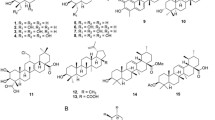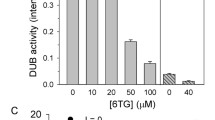Abstract
Serine hydrolases play crucial roles in many physiological and pathophysiological processes and a panel of these enzymes are targets of approved drugs. Despite this, most of the human serine hydrolases remain poorly characterized with respect to their biological functions and substrates and only a limited number of in vivo active inhibitors have been so far identified. Acylpeptide hydrolase (APEH) is a member of the prolyl-oligopeptidase class, with a unique substrate specificity, that has been suggested to have a potential oncogenic role. In this study, a set of peptides was rationally designed from the lead compound SsCEI 4 and in vitro screened for APEH inhibition. Out of these molecules, a dodecapeptide named Ala 3 showed the best inhibitory effects and it was chosen as a candidate for investigating the anti-cancer effects induced by inhibition of APEH in SAOS-2 cell lines. The results clearly demonstrated that Ala 3 markedly reduced cell viability via deregulation of the APEH-proteasome system. Furthermore, flow cytometric analysis revealed that Ala 3 anti-proliferative effects were closely related to the activation of a caspase-dependent apoptotic pathway. Our findings provide further evidence that APEH can play a crucial role in the pathogenesis of cancer, shedding new light on the great potential of this enzyme as an attractive target for the diagnosis and the quest for selective cancer therapies.






Similar content being viewed by others
References
Balch WE, Morimoto RI, Dillin A, Kelly JW (2008) Adapting proteostasis for disease intervention. Science 319:916–919
Trezza A, Cicaloni V, Pettini F, Spiga O (2020) Chapter 2-Potential roles of protease inhibitors in anticancer therapy. In: Gupta SP (ed) Cancer-leading proteases structures, functions, and inhibition. Academic Press, Massachusetts, pp 13–49
Poddar NK, Maurya SK, Saxena V (2017) Role of serine proteases and inhibitors in cancer. In: Chakraborti S, Dhalla N (eds) Proteases in physiology and pathology. Springer, Singapore, pp 257–287
Long JZ, Cravatt BF (2011) The metabolic serine hydrolases and their functions in mammalian physiology and disease. J Chem Rev 111:6022–6063
Bachovchin DA, Cravatt BF (2012) The pharmacological landscape and therapeutic potential of serine hydrolases. Nat Rev Drug Discov 11:52–68
Adibekian A, Martin BR, Wang C, Hsu KL, Bachovchin DA, Niessen S et al (2011) Click-generated triazole ureas as ultrapotent in vivo-active serine hydrolase inhibitors. Nat Chem Biol 7:469–478
Marshall I, Prince D, Johnson H, Ruiz D, Nicholaou M, Covey TM (2019) Analyzing the activity and expression of acyl peptide enzyme hydrolase (APEH) in the blood serum of patients with type II diabetes. BIOS 90:70–78
Polgár L (2002) The prolyl oligopeptidase family. Cell Mol Life Sci 59:349–362
Witheiler J, Wilson DB (1972) The purification and characterization of a novel peptidase from sheep red cells. J Biol Chem 247:2217–2221
Shimizu K, Kiuchi Y, Ando K, Hayakawa M, Kikugawa K (2004) Coordination of oxidized protein hydrolase and the proteasome in the clearance of cytotoxic denatured proteins. Biochem Biophys Res Commun 324:140–146
Palmieri G, Cocca E, Gogliettino M, Valentino R, Ruvo M, Cristofano G et al (2017) Low erythrocyte levels of proteasome and acyl-peptide hydrolase (APEH) activities in alzheimer’s disease: a sign of defective proteostasis? J Alzheimer’s Dis 60:1097–1106
Fujino T, Watanabe K, Beppu M, Kikugawa K, Yasuda H (2000) Identification of oxidized protein hydrolase of human erythrocytes as acylpeptide hydrolase. Biochim Biophys Acta 1478:102–112
Yamin R, Bagchi S, Hildebrant R, Scaloni A, Widom RL, Abraham CR (2009) Acyl peptide hydrolase degrades monomeric and oligomeric amyloid-beta peptide. Mol Neurodegener 4:33
Jessani N, Liu Y, Humphrey M, Cravatt BF (2002) Enzyme activity profiles of the secreted and membrane proteome that depict cancer cell invasiveness. PNAS 99:10335–10340
Erlandsson R, Boldog F, Persson B, Zabarovsky ER, Allikmets RL, Sümegi J et al (1991) The gene from the short arm of chromosome 3, at D3F15S2, frequently deleted in renal cell carcinoma, encodes acylpeptide hydrolase. Oncogene 6:1293–1295
Yamaguchi M, Kambayashi D, Toda J, Sano T, Toyoshima S, Hojo H (1999) Acetylleucine chloromethyl ketone, an inhibitor of acylpeptide hydrolase, induces apoptosis of U937 cells. Biochem Biophys Res Commun 263:139–142
Scaloni A, Jones W, Pospischil M, Sassa S, Schneewind O, Popowicz AM et al (1992) Deficiency of acylpeptide hydrolase in small-cell lung carcinoma cell lines. J Lab Clin Med 12:546–552
Palumbo R, Gogliettino M, Cocca E, Iannitti R, Sandomenico A, Ruvo M et al (2016) APEH inhibition affects osteosarcoma cell viability via downregulation of the proteasome. Int J Mol Sci 17:e1614
Bergamo P, Cocca E, Palumbo R, Gogliettino M, Rossi M, Palmieri G (2013) RedOx status, proteasome and APEH: insights into anticancer mechanisms of t10, c12-conjugated linoleic acid isomer on A375 melanoma cells. PLoS ONE 8:e80900
Palmieri G, Bergamo P, Luini A, Ruvo M, Gogliettino M, Langella E et al (2011) Acylpeptide hydrolase inhibition as targeted strategy to induce proteasomal down-regulation. PLoS ONE 6:e25888
Pautke C, Schieker M, Tischer T, Kolk A, Neth P, Mutschler W et al (2004) Characterization of osteosarcoma cell lines MG-63, Saos-2 and U-2OS in comparison to human osteoblasts. Anticancer Res 24:3743–3748
Isfort RJ, Cody DB, Lovell G, Doersen CJ (1995) Analysis of oncogenes, tumor suppressor genes, autocrine growth-factor production, and differentiation state of human osteosarcoma cell-lines. Mol Carcinogen 14:170–178
Niforou KM, Anagnostopoulos AK, Vougas K, Kittas C, Gorgoulis VG, Tsangaris GT (2008) The proteome profile of the human osteosarcoma U2OS cell line. Cancer Genom Proteom 5:63–78
Yu Y, Harris RI, Yang JL, Anderson HC, Walsh WR (2004) Differential expression of osteogenic factors associated with osteoinductivity of human osteosarcoma cell lines. J Biomed Mater Res 70A:122–128
Chen CC, Hwang JK, Yang JM (2009) (PS)2–v2: template-based protein structure prediction server. BMC Bioinform 10:366
Fiser A, Sali A (2003) Modeller: generation and refinement of homology-based protein structure models. Method Enzymol 374:461–491
Sali A, Blundell TL (1993) Comparative protein modelling by satisfaction of spatial restraints. J Mol Biol 234:779–815
Kiss AL, Hornung B, Rádi K, Gengeliczki Z, Sztáray B, Juhász T et al (2007) The acylaminoacyl peptidase from Aeropyrum pernix K1 thought to be an exopeptidase displays endopeptidase activity. J Mol Biol 368:509–520
Goodsell DS, Morris GM, Olson AJ (1996) Automated docking of flexible ligands: applications of AutoDock. J Mol Recognit 9:1–5
Guntert P (2004) Automated NMR structure calculation with CYANA. Methods Mol Biol 278:353–378
DeLano WL (2002) The pymol molecular graphics system. DeLano Scientific, Palo Alto. http://www.pymol.org
Vangone A, Spinelli R, Scarano V, Cavallo L, Oliva R (2011) COCOMAPS: a web application to analyze and visualize contacts at the interface of biomolecular complexes. Bioinformatics 27:2915–2916
Caraglia M, Passeggio A, Beninati S, Leardi A, Nicolini L, Improta S et al (1997) Interferon alpha2 recombinant and epidermal growth factor modulate proliferation and hypusine synthesis in human epidermoid cancer KB cells. Biochem J 324:737–741
Pfaffl MW (2001) A new mathematical model for relative quantification in real-time RT–PCR. Nucleic Acids Res 29:e45
Bradford MM (1976) A rapid and sensitive method for the quantitation of microgram quantities of protein utilizing the principle of protein-dye binding. Anal Biochem 72:248–254
Laemmli UK (1970) Cleavage of structural proteins during the assembly of the head of bacteriophage T4. Nature 227:680–685
Aljoundi A, Bjij I, El Rashedy A, Soliman MES (2020) Covalent versus non-covalent enzyme inhibition: which route should we take? A justification of the good and bad from molecular modelling perspective. Protein J 39:97–105
Palmieri G, Langella E, Gogliettino M, Saviano M, Pocsfalvi G, Rossi M (2010) A novel class of protease targets of phosphatidylethanolamine-binding proteins (PEBP): a study of the acylpeptide hydrolase and the PEBP inhibitor from the archaeon Sulfolobus solfataricus. Mol Biosyst 6:2498–2507
Palmieri G, Catara G, Saviano M, Langella E, Gogliettino M, Rossi M (2009) First archaeal PEPB-serine protease inhibitor from Sulfolobus solfataricus with noncanonical amino acid sequence in the reactive-site loop. J Proteome Res 8:327–334
Wright H, Kiss AL, Szeltner Z, Polgár L, Fülöp V (2005) Crystallization and preliminary crystallographic analysis of porcine acylaminoacyl peptidase. Acta Crystallogr F 61:942–944
Durand A, Villard C, Giardina T, Perrier J, Juge N, Puigserver A (2003) Structural properties of porcine intestine acylpeptide hydrolase. J Protein Chem 22:183–191
Hanahan D, Weinberg RA (2011) Hallmarks of cancer: The next generation. Cell 144:646–674
Cohen GM (1997) Caspases: the executioners of apoptosis. Biochem J 326:1–16
Lu Z, Zhang G, Zhang Y, Hua P, Fang M, Wu M et al (2018) Isoalantolactone induces apoptosis through reactive oxygen species-dependent upregulation of death receptor 5 in human esophageal cancer cells. Toxicol Appl Pharm 352:46–58
Zeng Z, Rulten SL, Breslin C, Zlatanou A, Coulthard V, Caldecott KW (2017) Acylpeptide hydrolase is a component of the cellular response to DNA damage. DNA Repair 58:52–61
Lopez-Otin C, Bond JS (2008) Proteases: multifunctional enzymes in life and disease. J Biol Chem 283:30433–30437
Mason SD, Joyce JA (2011) Proteolytic networks in cancer. Trends Cell Biol 21:228–237
Acknowledgements
The authors would like to thank Dr. Giovanni Del Monaco for his assistance with statistical analysis.
Funding
This research was supported by Regione Campania—“PREMIO-Infrastruttura per la Medicina di Precisione in Oncologia”. Manifestazione di interesse per la realizzazione di progetti di sviluppo/potenziamento di infrastrutture di ricerca strategica regionali per la lotta alle patologie oncologiche (RIS3)-POR CAMPANIA FESR 2014/2020. This work was partially supported by the Association Impegno per la Vita -Onlus, Pozzuoli, Napoli, Italy and by the CNR Project NUTR-AGE (FOE-2019, DSB.AD004.271).
Author information
Authors and Affiliations
Contributions
Conceptualization: GP; Methodology: EC, AS, LG, EI, LC; Formal analysis and investigation: MG, EC, GP; Writing-original draft preparation: MG, GP; Writing—review and editing: MG, EC, MR, GP; Funding acquisition: MR; Resources: GP; Supervision: MR, GP. All authors provided critical feedback and helped shape the research, analysis and manuscript.
Corresponding author
Ethics declarations
Conflict of interest
The authors declare that they have no conflict of interest.
Research involving human and animal rights
This article does not contain any studies with human participants or animals performed by any of the authors.
Additional information
Publisher's Note
Springer Nature remains neutral with regard to jurisdictional claims in published maps and institutional affiliations.
Supplementary Information
Below is the link to the electronic supplementary material.
Rights and permissions
About this article
Cite this article
Gogliettino, M., Cocca, E., Sandomenico, A. et al. Selective inhibition of acylpeptide hydrolase in SAOS-2 osteosarcoma cells: is this enzyme a viable anticancer target?. Mol Biol Rep 48, 1505–1519 (2021). https://doi.org/10.1007/s11033-020-06129-4
Received:
Accepted:
Published:
Issue Date:
DOI: https://doi.org/10.1007/s11033-020-06129-4




